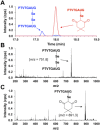Can dimedone be used to study selenoproteins? An investigation into the reactivity of dimedone toward oxidized forms of selenocysteine
- PMID: 29451338
- PMCID: PMC6295895
- DOI: 10.1002/pro.3390
Can dimedone be used to study selenoproteins? An investigation into the reactivity of dimedone toward oxidized forms of selenocysteine
Abstract
Dimedone is a widely used reagent to assess the redox state of cysteine-containing proteins as it will alkylate sulfenic acid residues, but not sulfinic acid residues. While it has been reported that dimedone can label selenenic acid residues in selenoproteins, we investigated the stability, and reversibility of this label in a model peptide system. We also wondered whether dimedone could be used to detect seleninic acid residues. We used benzenesulfinic acid, benzeneseleninic acid, and model selenocysteine-containing peptides to investigate possible reactions with dimedone. These peptides were incubated with H2 O2 in the presence of dimedone and then the reactions were followed by liquid chromatography/electrospray ionization mass spectrometry (LC/ESI-MS). The native peptide, H-PTVTGCUG-OH (corresponding to the native amino acid sequence of the C-terminus of mammalian thioredoxin reductase), could not be alkylated by dimedone, but could be carboxymethylated with iodoacetic acid. However the "mutant peptide," H-PTVTGAUG-OH, could be labeled with dimedone at low concentrations of H2 O2 , but the reaction was reversible by addition of thiol. Due to the reversible nature of this alkylation, we conclude that dimedone is not a good reagent for detecting selenenic acids in selenoproteins. At high concentrations of H2 O2 , selenium was eliminated from the peptide and a dimeric form of dimedone could be detected using LCMS and 1 H NMR. The dimeric dimedone product forms as a result of a seleno-Pummerer reaction with Sec-seleninic acid. Overall our results show that the reaction of dimedone with oxidized cysteine residues is quite different from the same reaction with oxidized selenocysteine residues.
Keywords: Pummerer reaction; dimedone; selenenic acid; seleninic acid; selenocysteine; sulfenic acid; sulfinic acid.
© 2018 The Protein Society.
Figures











Similar articles
-
Glutathione peroxidase's reaction intermediate selenenic acid is stabilized by the protein microenvironment.Free Radic Biol Med. 2014 Nov;76:127-35. doi: 10.1016/j.freeradbiomed.2014.07.041. Epub 2014 Aug 11. Free Radic Biol Med. 2014. Retraction in: Free Radic Biol Med. 2015 Oct;87:385. doi: 10.1016/j.freeradbiomed.2015.07.014. PMID: 25124921 Free PMC article. Retracted.
-
Methaneseleninic acid is a substrate for truncated mammalian thioredoxin reductase: implications for the catalytic mechanism and redox signaling.Biochemistry. 2010 Dec 7;49(48):10329-38. doi: 10.1021/bi101130t. Epub 2010 Nov 10. Biochemistry. 2010. PMID: 21038895 Free PMC article.
-
Loss of selenium from selenoproteins: conversion of selenocysteine to dehydroalanine in vitro.J Am Soc Mass Spectrom. 2003 Jun;14(6):593-600. doi: 10.1016/S1044-0305(03)00141-7. J Am Soc Mass Spectrom. 2003. PMID: 12781460
-
Selenoproteins-What unique properties can arise with selenocysteine in place of cysteine?Exp Cell Res. 2010 May 1;316(8):1296-303. doi: 10.1016/j.yexcr.2010.02.032. Epub 2010 Mar 3. Exp Cell Res. 2010. PMID: 20206159 Review.
-
Common modifications of selenocysteine in selenoproteins.Essays Biochem. 2020 Feb 17;64(1):45-53. doi: 10.1042/EBC20190051. Essays Biochem. 2020. PMID: 31867620 Review.
Cited by
-
Selenium versus sulfur: Reversibility of chemical reactions and resistance to permanent oxidation in proteins and nucleic acids.Free Radic Biol Med. 2018 Nov 1;127:228-237. doi: 10.1016/j.freeradbiomed.2018.03.035. Epub 2018 Mar 26. Free Radic Biol Med. 2018. PMID: 29588180 Free PMC article. Review.
-
Can Selenoenzymes Resist Electrophilic Modification? Evidence from Thioredoxin Reductase and a Mutant Containing α-Methylselenocysteine.Biochemistry. 2020 Sep 15;59(36):3300-3315. doi: 10.1021/acs.biochem.0c00608. Epub 2020 Aug 30. Biochemistry. 2020. PMID: 32845139 Free PMC article.
-
Biological and Catalytic Properties of Selenoproteins.Int J Mol Sci. 2023 Jun 14;24(12):10109. doi: 10.3390/ijms241210109. Int J Mol Sci. 2023. PMID: 37373256 Free PMC article. Review.
References
-
- Reich HJ, Hondal RJ (2016) Why nature chose selenium. ACS Chem Biol 11:821–841. - PubMed
Publication types
MeSH terms
Substances
Grants and funding
LinkOut - more resources
Full Text Sources
Other Literature Sources

